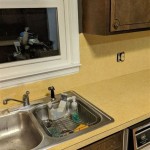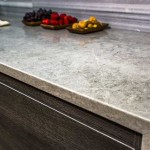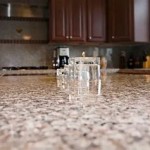Quartz Bathroom Countertop With Integrated Sink: A Seamless Blend of Aesthetics and Functionality
The bathroom, once a purely utilitarian space, has evolved into a personal sanctuary, a place for relaxation and rejuvenation. As such, homeowners and designers are increasingly seeking materials and designs that combine beauty, durability, and ease of maintenance. The quartz bathroom countertop with integrated sink represents a significant advancement in bathroom design, offering a seamless and sophisticated solution that meets these criteria.
An integrated sink, in this context, refers to a sink basin that is directly molded or attached to the countertop itself, creating a continuous surface without visible seams or joints. This contrasts with traditional sinks, which are typically separate units installed on or under the countertop. This integration results in a clean, modern aesthetic, while offering practical benefits that extend beyond mere appearance.
Quartz, an engineered stone composed of approximately 90-95% ground quartz and 5-10% resins, polymers, and pigments, is a popular material choice for countertops due to its exceptional strength, durability, and resistance to staining. When combined with the integrated sink design, quartz offers a superior alternative to traditional materials like ceramic, porcelain, or even natural stone.
The Aesthetic Appeal of Integrated Quartz Sinks
The primary advantage of a quartz bathroom countertop with integrated sink is its sleek and contemporary appearance. The seamless design provides a minimalist aesthetic that appeals to modern design sensibilities. The absence of visible joints or rims eliminates potential areas for dirt and grime to accumulate, contributing to a cleaner and more hygienic environment. Furthermore, the continuity of the surface allows the natural beauty of the quartz material to shine through, uninterrupted by the visual clutter of a separate sink basin.
The visual harmony created by the integrated design can significantly enhance the overall appeal of the bathroom. Instead of the sink appearing as a separate element, it becomes an integral part of the countertop, blending seamlessly into the surrounding space. This cohesion contributes to a more unified and aesthetically pleasing design. This visual advantage extends beyond mere style; it also creates a perception of increased space, which is particularly valuable in smaller bathrooms. The absence of visual breaks and disruptions allows the eye to flow smoothly across the surface, creating a sense of openness and airiness.
Quartz, being an engineered material, offers a wide range of color options and patterns. This allows homeowners to choose a countertop and integrated sink that perfectly complements their existing bathroom decor. From subtle and muted tones to bold and vibrant hues, the design possibilities are virtually limitless. The ability to customize the color and pattern of the quartz allows for a truly personalized bathroom space, reflecting the homeowner's individual style and preferences.
The clean lines and smooth surfaces of an integrated quartz sink also lend themselves well to a variety of design styles, from minimalist and contemporary to transitional and even traditional. The versatility of the material allows it to be incorporated seamlessly into different bathroom aesthetics, making it a popular choice among designers and homeowners alike.
Practical Benefits: Hygiene, Durability, and Maintenance
Beyond its aesthetic appeal, the quartz bathroom countertop with integrated sink offers significant practical advantages. The seamless construction eliminates the crevices and joints that are common in traditional sink installations, making it significantly easier to clean and maintain. These joints can be breeding grounds for bacteria and mold, requiring meticulous cleaning to prevent the buildup of grime and mildew. With an integrated sink, these problem areas are effectively eliminated, simplifying the cleaning process and promoting a more hygienic environment.
The non-porous nature of quartz further enhances its hygiene. Unlike natural stone or even some types of ceramic, quartz is resistant to staining and the absorption of liquids. This means that spills and splashes are easily wiped away without leaving behind unsightly marks or harboring bacteria. The smooth, impervious surface also inhibits the growth of mold and mildew, further contributing to a cleaner and healthier bathroom environment. This resistance to staining makes it ideal for bathrooms where frequent use of soaps, lotions, and other personal care products is commonplace.
Durability is another key advantage of quartz. As an engineered stone, quartz is exceptionally strong and resistant to scratches, chips, and cracks. It is far more durable than natural stone materials like granite or marble, which can be prone to damage from everyday use. This durability ensures that the quartz countertop and integrated sink will maintain its appearance and functionality for many years to come, even with heavy use. The resilience of quartz against impact also makes it a safer option, reducing the risk of accidental damage that could lead to costly repairs or replacements.
The low-maintenance nature of quartz is another compelling reason to choose this material for bathroom countertops and integrated sinks. Unlike natural stone, quartz does not require sealing to protect it from staining and water damage. A simple wipe down with a mild soap and water solution is typically all that is needed to keep the surface clean and looking its best. This minimal maintenance requirement makes quartz an ideal choice for busy homeowners who want a beautiful and functional bathroom without the hassle of constant upkeep.
Installation Considerations and Design Options
While the installation of a quartz bathroom countertop with integrated sink is generally straightforward, it is crucial to hire a qualified professional to ensure a proper fit and seamless integration. Precise measurements and careful installation are essential to avoid any gaps or uneven surfaces that could compromise the aesthetics or functionality of the countertop. A professional installer will have the necessary tools and expertise to ensure that the countertop is properly supported and securely attached to the cabinetry.
When selecting a quartz countertop with an integrated sink, there are several design options to consider. The shape and size of the sink basin can be customized to suit individual needs and preferences. Options include rectangular, oval, and round basins, as well as single or double sink configurations. The depth of the sink can also be adjusted to accommodate different uses, from washing hands to filling larger containers.
Edge profiles are another important design consideration. The edge of the countertop can be rounded, beveled, or squared off to create different aesthetic effects. A rounded edge can provide a softer and more comfortable feel, while a squared-off edge can create a more modern and minimalist look. The choice of edge profile should complement the overall design of the bathroom and the style of the sink basin.
The placement of the faucet and other fixtures should also be carefully planned. The faucet can be mounted directly on the countertop, or it can be wall-mounted to create a cleaner and more streamlined look. The placement of the drain and overflow should also be considered to ensure proper drainage and prevent water damage.
Lighting plays a crucial role in highlighting the beauty and functionality of the quartz countertop with integrated sink. Under-cabinet lighting can provide a warm and inviting glow, while task lighting can illuminate the sink area for better visibility. The choice of lighting should complement the overall design of the bathroom and enhance the user experience.
Choosing the right color and pattern of quartz is essential for creating a cohesive and aesthetically pleasing bathroom design. Consider the existing color palette of the bathroom and select a quartz countertop that complements the surrounding elements. Light colors can create a sense of spaciousness, while darker colors can add drama and sophistication. The pattern of the quartz can also influence the overall look and feel of the bathroom. Subtle patterns can create a sense of texture and depth, while bolder patterns can add visual interest and personality.

Sinks Corian Quartz

Integrated Bathroom Sink And Countertop Check More At Http S2pvintage Com 21401 Integ Quartz Vanity Tops With

Sink Integrated Custom Quartz Countertop Kitchen Bathroom Vanity Wall Mounted Etsy

Quartz Integrated Sinks Modern Vanity Tops And Side Splashes San Francisco By Custom Stone Bathroom

Bathroom Vanity Countertops Norfolk Kitchen Bath

Bathroom Remodelling Is Quartz Sink Worth It

The Neutra Quartz Integrated Sink A Triumph Of Form And Function

Ceramic Vanity Top With Integrated Sink

Quartz Bathroom Vanity With Single Sink Vessel Etsy

What Is Integrated Sink Why You Should Have One
See Also








